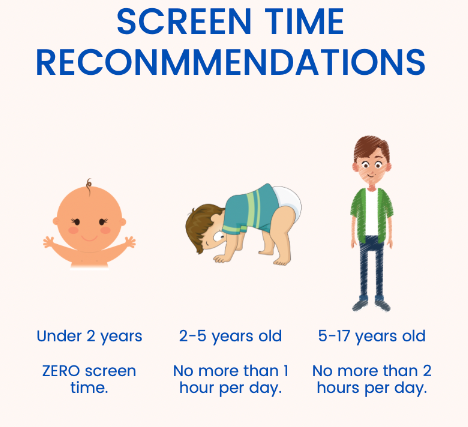In today’s digital age, devices like smartphones, tablets, and computers are integral to everyday life. While these tools offer significant educational and entertainment benefits, excessive screen time can have adverse effects on children’s physical, emotional, and social development. Understanding screen time recommendations for kids is crucial for parents striving to create a balanced approach to technology use. By setting clear boundaries and encouraging healthy habits, families can ensure that screens enhance rather than hinder a child’s well-being.
Understanding the Impact of Screen Time
Why Screen Time Matters
Children’s exposure to screens impacts several areas of development:
- Physical Health: Prolonged screen use can lead to issues like poor posture, eye strain, and lack of physical activity, increasing the risk of obesity.
- Mental Well-Being: Overuse of devices is linked to sleep disturbances, anxiety, and decreased attention spans.
- Social Skills: Excessive screen use may hinder face-to-face interactions and emotional connections.
While screens are not inherently harmful, their effects depend on how, when, and for how long they’re used.
What Are the Recommended Limits?
Organizations like the American Academy of Pediatrics (AAP) offer guidelines to help parents manage screen time:
- Ages 0–2: Avoid screens except for video chatting.
- Ages 2–5: Limit screen time to one hour per day of high-quality programming.
- Ages 6 and Up: Encourage consistent limits to ensure a healthy balance between screen use and other activities, such as sleep, physical play, and homework.
Strategies for Managing Screen Time
1. Establish Clear Boundaries
Setting clear rules around screen usage helps create structure and consistency.
- Define Time Limits: Use timers or parental control apps to regulate daily screen time.
- Designate Screen-Free Zones: Ensure spaces like the dining room or bedrooms are device-free to promote quality family interactions and better sleep.
- Create a Routine: Allocate specific times for screen use, such as educational apps during study hours or entertainment after chores.
2. Encourage Alternative Activities
Reducing screen time becomes easier when children are engaged in other activities.
- Outdoor Play: Encourage physical activities such as sports, biking, or simply playing in the yard.
- Creative Hobbies: Provide opportunities for drawing, reading, or crafting to nurture creativity and critical thinking.
- Social Interaction: Facilitate in-person playdates or family outings to strengthen social bonds.
3. Monitor Content Quality
Not all screen time is created equal. Prioritize content that is age-appropriate, educational, and interactive.
- Educational Apps and Games: Choose programs that promote learning and skill development.
- Family-Friendly Viewing: Opt for shows or movies that align with family values and encourage co-viewing to foster discussions.
- Avoid Passive Consumption: Limit content that involves mindless scrolling or prolonged exposure to advertisements.
Subheading: Balancing Screen Time With Healthy Habits
Achieving a balance between screen use and overall well-being involves addressing the following aspects:
- Sleep Hygiene: Ensure children turn off screens at least one hour before bedtime to improve sleep quality. The blue light from devices can disrupt melatonin production and delay sleep.
- Physical Activity: Aim for at least one hour of moderate to vigorous physical activity daily, as recommended by health experts.
- Family Time: Dedicate periods for screen-free family bonding, such as playing board games, cooking together, or sharing stories.
The Role of Parents in Managing Screen Time
Parents play a pivotal role in shaping their child’s relationship with technology. Here are ways to lead by example:
- Model Healthy Behaviors: Limit your own screen use during family time to demonstrate balanced technology habits.
- Communicate Openly: Discuss the potential effects of excessive screen use with your child and involve them in setting boundaries.
- Stay Informed: Keep up with the latest research and recommendations about screen use to make informed decisions.
When to Seek Help
If screen time is interfering with your child’s daily activities, academic performance, or emotional well-being, consider seeking guidance from a healthcare professional. Behavior changes, such as aggression when screens are removed, may also indicate deeper concerns.
Conclusion
Establishing and following screen time recommendations for kids is vital for promoting healthy development and preventing the negative impacts of excessive screen use. By setting boundaries, encouraging alternative activities, and modeling responsible behavior, parents can create a balanced digital environment that benefits the entire family. Remember, the goal isn’t to eliminate screens but to use them mindfully to enrich your child’s life and learning experiences. A proactive approach today ensures a healthier, more balanced future for your child.
